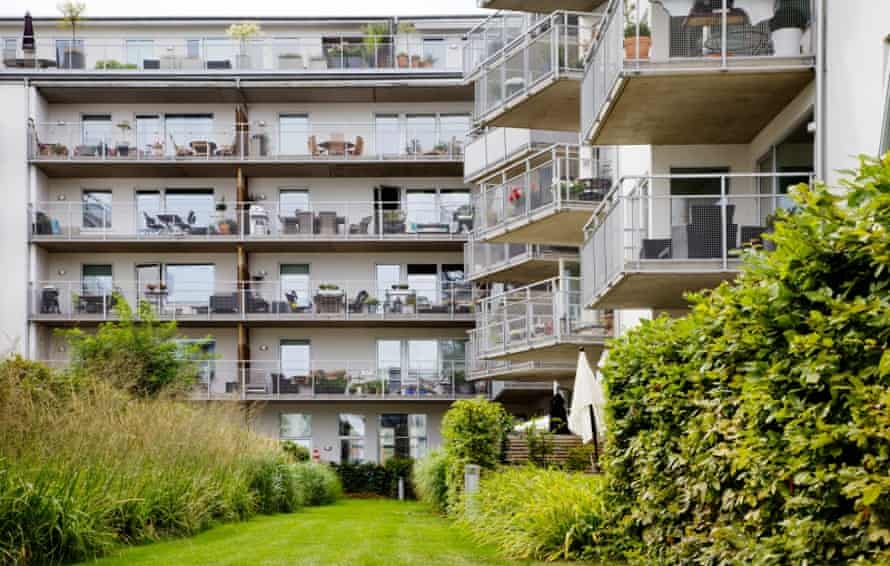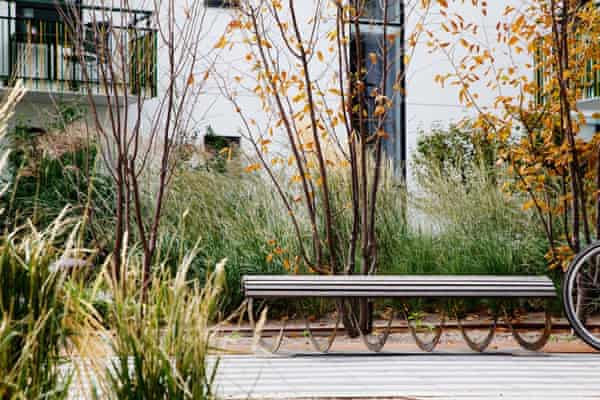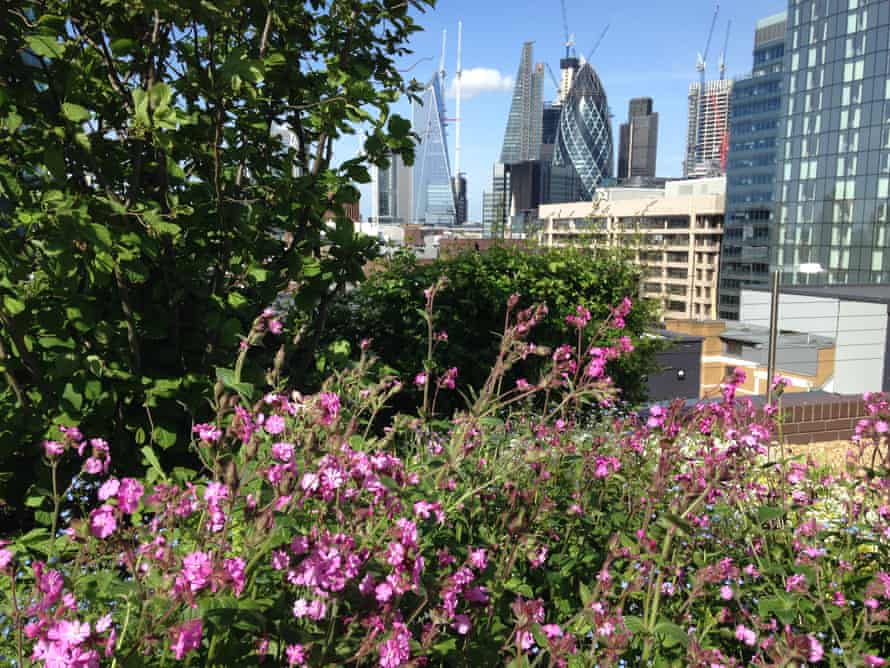Nature calling: how can Sweden’s success story help rewild London?
If you wish to see one of the best of what the town of Malmö’s “green points” system can obtain, head right into a neighbourhood referred to as Bo01, says panorama architect Anne Brontér. There, on the waterfront of the Western Harbour, you’ll discover a cluster of housing blocks, every completely different from the following, however all centred on a nature-filled courtyard.
Sandwiched between parks, these courtyards, assembly areas and pocket parks, are house to beds planted with a mixture of native herbs and wildflowers, creeper crops and sustainable stormwater drains that double as wildlife ponds.
London will grow to be the most important metropolis on the earth to introduce a inexperienced area system within the coming weeks as a part of mayor Sadiq Khan’s London Plan, which was signed off by the housing secretary, Robert Jenrick, on the finish of January. Called the Urban Greening Factor (UGF), the plan requires boroughs to implement city greening practices, with a handful – together with Hackney and the City – already one step forward. Much of the inspiration has come from the Swedish metropolis.
At the flip of the millennium, all the Western Harbour, a 20-minute stroll from Malmö’s centre, was little greater than 70 hectares (175 acres) of contaminated soil and abandoned docklands, following the dramatic decline of the town’s shipbuilding trade. Bo01 (Bo means “live” in Swedish and 01 is brief for 2001, the 12 months the neighbourhood opened) was step one within the space’s post-industrial regeneration, timed to coincide with the development of the Øresund Bridge that linked Malmö to Copenhagen.
Built as a mannequin group for a housing exposition, which heralded it because the “sustainable city of tomorrow”, Bo01 aimed to be the world’s first carbon impartial neighbourhood, powered by wind and heated by an underground geothermal hotspot.
From the outset, every of Bo01’s house blocks needed to meet a inexperienced area issue (GSF), in accordance with a metropolis coverage that demanded each improvement put aside a share of its footprint as inexperienced area and initially gave out biodiversity-focused bonus factors for something from tall fruiting bushes and potted crops on the roadside, to tiny birdhouses and frog-filled ponds. What resulted have been eclectic, characterful and distinct inexperienced social areas, in accordance with Brontér, who additionally works for Malmö’s planning division. “The courtyards are where you can see a difference in the use of the green space factor.”
“It was that, I think, that really grabbed me,” says Peter Massini, who visited in 2017. Massini led inexperienced infrastructure initiatives on the Greater London Authority (GLA) for 12 years, till December, and championed the framework to grow to be a part of London’s future.
“You walk around that part of Malmö and there are no parks with fences around them. Whereas the British model has been about physically protecting [green space], you get to Malmö and it’s got these green spaces and parks which are part of the public realm.”
First applied in Berlin in 1994, the GSF framework is right this moment one of the broadly adopted coverage instruments for city greening, and has been applied in Seattle, Hamburg, Southampton and Stockholm. Cities adapt the core GSF system to present completely different values to particular kinds of inexperienced area, for instance, giving a better worth to ponds and areas for stormwater runoff in neighbourhoods with poor drainage. The formulation permits metropolis governments to combine biodiversity-focused incentives for something from animal habitats to native planting.
Q&AGreen area issue – how does it work?
The inexperienced area issue (GSF) – typically referred to as an city greening issue or inexperienced space issue – is a approach of calculating inexperienced area necessities for brand spanking new developments.
GSF measures usually give every sq. metre of tarmacked automotive park a rating of zero and each sq. metre left as open meadow a price of 1. Other areas can earn increased or decrease scores. In Malmö, a pond or stormwater system full of water for greater than half the 12 months additionally scores one, a permeable gravel space with some crops has a price of 0.4, and paved areas designed to channel stormwater into sustainable drainage programs rating 0.2.
These numbers are added up and divided by the full space of the event to present a rating. Cities might demand that every improvement reaches a minimal goal, usually 0.3.
But whereas Londoners would possibly hope this new coverage will spark a wave of inventive rewilding, even Malmö’s supporters urge warning. A GSF system creates alternatives to understand the advantages of city nature, fairly than guaranteeing real change – with successes corresponding to Bo01 additionally counting on a mix of complementary planning insurance policies, participatory design processes, and ecological enter.

When Malmö started constructing Bo01, a neighbourhood of about 1,400 houses in largely 4 or five-storey housing blocks, its publicly-owned improvement firm labored with panorama architects to make sure blocks met the required GSF rating, bringing designers’ experience to bear on oft-neglected courtyards and roadsides, says Brontér. The GSF solely utilized to those housing developments, with parks and public areas nonetheless put aside as a part of an space masterplan.
GSF programs are greatest outfitted to make sure a backside line for inexperienced area in new developments and helped set up the leafy, various character of Bo01, says Tobias Emilsson, researcher in city landscapes on the Swedish University of Agricultural Sciences. Advocates – such because the EU’s Green and Blue Space Adaptation for Urban Areas and Eco Towns (GRaBS) initiative – say that one among their most essential attributes is that the core framework is well tailored and tweaked for various cities. Malmö, for instance, briefly boosted the worth of recent concepts corresponding to inexperienced roofs, which they inspired native folks to undertake. Once a novelty, “now, even your local contractor will know how to put [one] up”, says Emilsson.
Above all, nonetheless, it’s a hands-off method that enables every improvement’s designers and designers to be conscious of native wants, Massini says. “It is intended to encourage dialogue and collaboration between different stakeholders to come up with the best solution for the space. It was designed deliberately to be a little bit loose. My biggest fear, what I wanted to avoid doing, is it being prescriptive.”
In Malmö, although, preliminary successes flattered the system. As the Western Harbour improvement unfold to Bo01 neighbour Flagghusen, the GSF system was simplified, and the system was “applied less stringently”, writes GRaBS report writer Annika Kruuse, former challenge supervisor for the town of Malmö. This sought to scale back the excessive price of improvement in Bo01 – which led to an prosperous, largely white inhabitants unrepresentative of Malmö’s various demographics – and to construct extra reasonably priced housing.

Landscape designers proceed to be concerned in evolving initiatives, however with out the in-depth participation seen in Bo01, says Brontér. And gone are the bonus factors for bat packing containers and hedgehog houses.
Crucially, 20 years on, it’s tough to indicate the long-term biodiversity advantages from GSF in Bo01. Anecdotal proof and one 2002 study confirmed an uplift in pure range, a 12 months after building, however studies by graduate students in Emilsson’s division discovered some inexperienced areas have been later lined over.
Perhaps the most important lesson to be discovered for London, is that personal builders quickly discovered shortcuts. “I think it was really clear in Bo01 that the developers quite quickly caught the idea of what is the cheapest solution to get the maximum factor,” says Emilsson. “Sedum roofs were rated really high so there’s a lot of sedum roofs,” with repetition limiting the advantages to wildlife.
Other developments have been overcrowded with bushes, says Brontér. “They got a high, high score, but in the long-term perspective, perhaps it would have been better with fewer trees.
“The positive side is that it’s very easy to understand,” she says. “It’s easy for politicians to have high ambitions in [saying] we want to have a high green area factor. But they don’t really understand that you can’t just say ‘We want to have a high number’ because it all depends on the site.

“There’s an obvious risk that it becomes a bit of a green-washing tool. But I think the danger is that everyone involved believes that using the GSF makes everything long-term greener. And I’m not sure it does; we don’t know if it does.”
Stockholm has taken classes from Malmö, and created a extra advanced GSF system that scores developments individually for biodiversity, local weather adaptation (together with water administration), and social and aesthetic components.
Massini is underneath no illusions in regards to the limits of London’s inexperienced space framework. Having departed the GLA on the finish of 2020, he’s comfortable to be leaving with not solely the UGF set for the London Plan, however a set of city greening insurance policies. These embrace two key rights to entry of open inexperienced area and the requirement that developments contribute to a biodiversity web acquire.
He argues the UGF must be seen as a “supplementary policy” that may permit developments so as to add to London’s conventional greenery. The kind of questions UGF asks embrace: “What is the specific detailing you do on that development that provides a stepping stone for wildlife? Can you create some wetland features so it allows dragonflies from Walthamstow Marshes to forage more widely in the urban environment? Or does it provide a corridor of trees which allows bats to go from the Regent’s Canal to a nearby park, adding in those little links that just give wildlife a chance to thrive beyond the boundaries of the protected areas.”
In phrases of selling wilding, Massini sees probably the most potential for the UGF not within the mega-developments, such because the Olympic Park, however in creating incremental features across the fringe of parks, or between inexperienced areas, or in dense neighbourhoods like Tower Hamlets or Elephant and Castle, the place biodiversity has been close to zero for many years, maybe centuries.
GSF can function within the locations the place there’s no conventional conservation effort, says Mathew Frith, director of conservation at London Wildlife Trust. While we’ll nonetheless want to guard the chalk grasslands in the south of the city, our uncommon remaining peat bogs and historical woodland, there may be loads of area for extra casual biodiversity, he says.

“Cities are always going to be melting pots of people and nature,” says Frith. “We have something like 15,000 species recorded in London, and a great proportion of those species come from other parts of the world through trade, gardening, food, textiles, etc. And so we’ve got this kind of cosmopolitan nature. And so, we can’t get too precious about some of those designs that are made.”
Landscape architect Klaus Overmeyer, from Berlin, the house of GSF, says the town’s coverage was a fringe difficulty when adopted within the Nineteen Nineties, when inexperienced area and disused corners of the town have been plentiful, however has grow to be extra key as Berlin’s land values have rocketed. Yet, he says, coverage has mattered lower than native folks’s participation within the creation of the town’s unexpected green spaces.
Both Berlin and Malmö can educate London that recording values for greenery, “as if in a spreadsheet” is simply helpful if somebody on the councils can nonetheless scrutinise a planning utility and make sense of what these numbers would possibly imply for the flourishing of native life, says Frith. Today, amongst London’s cash-strapped native authorities, solely half have an ecologist on workers, and most should not in planning departments.
“For all the benefits of these tools – and they are tools – they are not necessarily the final answer,” he says. “Having informed ecological expertise is still critical.”
Find extra age of extinction coverage here, and observe biodiversity reporters Phoebe Weston and Patrick Greenfield on Twitter for all the newest information and options




